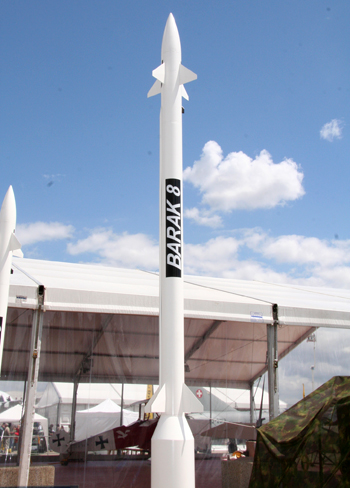INDIAN ARMED FORCES CHIEFS ON
OUR RELENTLESS AND FOCUSED PUBLISHING EFFORTS

SP Guide Publications puts forth a well compiled articulation of issues, pursuits and accomplishments of the Indian Army, over the years

I am confident that SP Guide Publications would continue to inform, inspire and influence.

My compliments to SP Guide Publications for informative and credible reportage on contemporary aerospace issues over the past six decades.
- Interim Defence Budget 2024-25 — An Analysis
- Union Defence budget 2024
- Indian Army: In quest of greater firepower and policy recommendations for gaps
- Indian Army Annual Press Conference 2024
- 6G will transform military-industrial applications
- Tata Boeing Aerospace Delivers 250 AH-64 Apache Fuselages, Manufactured in India
New Long Range SAM
 |
By Lt. General P.C. Katoch (Retd) Former Director General of Information Systems, Indian Army |

Barak-8
India successfully conducted the second test of the new Indo-Israeli surface to air missile (LRSAM) on September 20 from the launching complex - III of the Integrated Test Range (ITR) at Chandipur-on-sea. The missile's first test was carried out at about 10.15 am in a similar configuration. The second missile was fired against a pilot-less target aircraft (PTA) to gauge the killing efficiency of the system and it achieved a direct hit. The test conducted in wake of the Pakistan sponsored terrorist attack at Uri had some critics on the social media writing why do we need LRSAMs when the threat on ground is terrorism. Views were also expressed that India does not know its priorities - instead of making dedicated satellites which can monitor the borders day and night and provide live videos, they're busy with lesser necessities like this test. However, while the need for satellite monitoring of our borders is essential, so is the need to simultaneously galvanize our air defence, latter being as vital.
It may be recalled that on June 30 this year, India had successfully test-fired for the first time a land based version of Barak 8 medium range surface-to-air missile (MRSAM) jointly developed this missile in collaboration with Israel Aerospace Industries (IAI) hitting the target PTA. Again on July 1 the MR SAM (land based version) was tested for the third time from the same integrated test range and the missile successfully hit a PTA, proving its reliability. This MRSAM has been manufactured at the Hyderabad-based Bharat Dynamics Limited (BDL). Many Indian industries like BEL, L&T, BDL, TATA group of companies plus some other private industries contributed to the development of a number of subsystems which were put to use in these flight tests. Earlier on 29 December 2015 and 30 December 2015 the Indian Navy had successfully test-fired the Barak 8 missile from INS Kolkata; two missiles firing at high speed targets during naval exercises in the Arabian Sea. The advanced missile system LRSAM jointly designed and developed by India's DRDO and Israel Aerospace Industries (IAI), includes a Multi-Functional Surveillance and Threat Alert Radar (MF STAR) for detection, tracking and guiding the weapon system. The missile along with MF-STAR would provide users the capability to neutralize any aerial threats. As mentioned earlier, the Indian Navy had also successfully test launched the LRSAM on the Western Seaboard by INS Kolkata on December 30, 2015.
These missiles would be inducted in all the three services after the serial trials are completed. Many Indian industries like BEL, L&T, BDL, Midhani, Godrej, SEC, PEL, Aditya and TATA group of companies besides other private industries have contributed to the development of a number of subsystems which have been put into use in this flight test. Both Israel and Indian scientists and technicians have been involved in the launch campaign. The LRSAM having a strike range of 90 km would help fill the gap that India has in its air defence arsenal at present and will provide the users with the capability to neutralize any aerial threats. It can carry a payload of 60 kg and flies at a speed of Mach 2. The weapon system which weighs around 2.75 tons will provide aerial protection to sensitive defence installations and crowded metropolitan cities of the country. These successful are important achievements that would pave the way fpr production of the system and fielding of these missiles into the three Services.
In January 2007, India and Israel had signed a US$330 million deal to co-develop an all new generation of the Barak SAM. It can identify and destroy airborne threats like jets, missiles and rockets, including projectiles launched simultaneously. The Mach 2 speed missile possesses high degrees of maneuverability at target interception range. The successful conduct of the test has been the result of sustained efforts by all stake holders over the years which would provide a fillip to the air strike operations. A new production facility to deliver 100 missiles per year has been established for such type of long and medium-range surface-to-air missiles at Bharat Dynamics Limited. The Army will be particularly happy with its air defence equipment holdings largely obsolete. With the Akash missile failing as substitute for the vintage Russian Kvadrat system for providing air defence cover to mechanized formations on the move, if the Barak 8 MR SAM can eventually meet this requirement also, it will be a tremendous plus. As per reports, the Barak 8-ER (extended range) variant of the Barak 8 is also under development, which will see the missiles maximum range increased to 150 km. These long and medium range Barak 8 SAMs coupled with the S-400 Triumf long-range surface-to-air missile systems from being procured from Russia will provide the vital boost to air defene cover in India.
Photo Credit: Wikipedia





